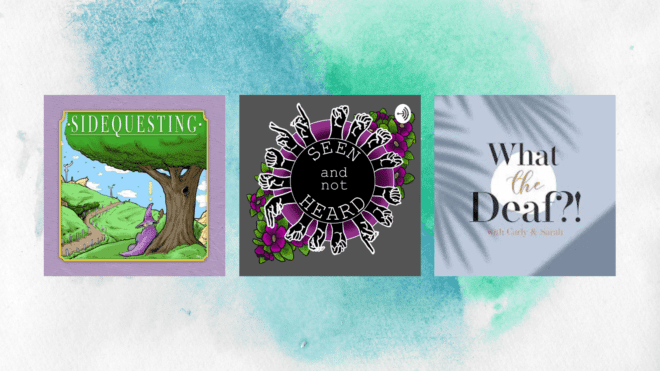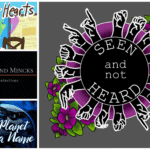Most De(a)f Representation in Podcasting

2020 saw the amplification of marginalized voices in a time when we needed them the most. With each new podcast released we saw new and innovative ideas told through storytelling and sound design. The following list first began as a way to highlight a group most folks do not consider when they hear ‘sound design’: The Deaf Community. This quickly turned into an article about Deaf representation and the ways the podcasting community has failed an oft-forgotten community.
Before I really get into it, I want to take a moment to define my own identity as well as some terms I will be using throughout the article. The reason I pitched this article was because I am deaf. I began to lose my hearing in sophomore year of college, and, despite my best efforts, my hearing has been slowly degrading ever since. I wrote this article not just to highlight Deaf creators, but to also explore the ways I and others could continue to engage with the podcasting community, in spite of our disability.
So! Some terms I will need to define. Deaf (with an uppercase “D”) is generally referred to someone with no functional hearing or someone who has been Deaf from birth. It can also be used to describe people who are culturally “active members” of the Deaf Community, meaning they communicate in sign language and consider being Deaf a cultural identity. The word deaf (with a lowercase “d”) usually refers to someone who has gradually lost their ability to hear and/or do not consider themselves to be apart of the Deaf Community. Hard of Hearing (or “HoH”), simply put, is just a term to refer to someone with mild to moderate hearing loss. With all of that out of the way, let’s dive into it.

What the Deaf?!
The What the Deaf?! podcast, an unscripted, conversational podcast, offers one of the most honest looks into what it means to be Deaf in a hearing world, and does so in a way I had never heard (haha) of before. The hosts of this podcast, Sarah Tubert and Carly Weyers, communicate via American Sign Language, with Carly Weyers being voiced in English by Jenny Corum. The two (well, three), discuss everything, from identity to dating to the struggles of their day to day lives. Tubert and Weyers aim to educate the hearing community on what it means to be Deaf and to bridge the gap between their two communities. This podcast is such a special piece of media because it reinforces the idea that there’s no right way to be Deaf. Both of these woman come from completely different backgrounds but are able to come together to share and revel in their shared experiences: the ableism they face, the small joys of being Deaf, and the warmth they’ve been shown in both the Deaf and hearing community. Though the podcast is still relatively new, each episode is a delight to listen to and offers great insight into their world.
Apple Podcasts | Pocket Casts | Stitcher | Website | RSS
Sidequesting, “2.1: Honor Among Thieves”
While Sidequesting, as a whole, does not feature any d/Deaf or Hard of Hearing characters, I would love to touch on the episode “Honor Among Thieves.” This episode does have a Deaf character, played by Caroline Mincks, a deaf voice actor and creator. Mincks plays a dashing leader of a small group of rogues. More impressively, this episode also includes a fantasy sign language. Not only does this daring gang of thieves use it to communicate between each other, they also use it during their stealth missions to rob the greedy lord that rules their city. The sound design is particularly well done, as you can actually hear the motion of these characters hands as they sign. It is such a small detail, but it adds such a realism to the world.
I had a chance to speak with Tal Minear, the creator and sound designer, about their process for designing this episode. Minear wanted an audible indicator for their signing, something “in your face.” They felt it was important to include because, even though the signing was translated for Rion and the audience, it was a good reminder for the audience as well. Brad Colbroock provided the actual noises the singing made throughout the episode. Needless to say, that aspect was very much appreciated.
Apple Podcasts | Pocket Casts | Stitcher | Website | RSS |Transcripts

Seen and Not Heard
Seen and Not Heard is a recent audio drama (or fiction podcast) that explores the life of Bet Kline, a young woman who is slowly losing her hearing. This story is lovingly crafted by Caroline Mincks, who is also deaf, with sound design done by Tal Minear. This story feels incredibly genuine and the sound design is top notch. Seen and Not Heard accurately explores what it’s like to lose your hearing and the frustrating experience of how others react to and treat d/Deaf and hard of hearing people, who are just trying to live their life as best they can. Throughout the show, Bet is faced with prejudices from friends, family and even the Deaf community but more importantly, it focuses on how d/Deaf people are still just that; people. People with hopes and dreams. People who still deserve respect despite the struggles they face.
Bet’s journey of self-discovery is truly inspiring and her frank discussions of those struggles and doubts brought me to tears quite a few times during my (multiple) listens. Mincks delivers beautiful prose about their frustrations as a deaf person along with hilariously sharp wit about it all.
I would also be remiss if I didn’t touch upon the sound design of the show. Tal Minear is a true mastermind when it comes to designing this world. They take us through how Bet experiences sound and, as someone who is also partially deaf, it is incredibly accurate. The muffled, overwhelming muddle of sounds, or lack thereof, and the subtly of the noises you truly miss out on is orchestrated so perfectly. There were a few moments while I was listening to the first episode where I was concerned that my own hearing had worsen, only to realize it was just Minear working their magic.
I was able to speak with Mincks and Minear about the process for designing these scenes. There was “a lot of back and forth with Caroline [Mincks],” says Minear. Mincks was able to send them videos with examples of moderate to severe hearing loss and after Minear designed the scene, would send back to Mincks, who provided feedback about sound levels. As the two of them got more used to designing sound, or the lack of it, it got easier. Minear went on to describe how they went on to layer dozens of sounds and effects over each other: “Every voice had its own thing done to it, so it wasn’t just slapping a muffled filter over it. A lot of very fine tuned layers on each individual aspect.” Seen and Not Heard’s last episode was released today, January 22nd, 2021, making it a great time to get caught up.
Apple Podcasts | Pocket Casts | Website | RSS
Honestly, I could go on forever about why I adore Seen and Not Heard, but for the sake of this article, I want to move on to touch on an unfortunate truth within the podcast community.
(Note: The Big Loop‘s “Surfacing” and The AM Archives also include d/Deaf characters.)
The Unfortunate Truth
As you can probably tell from the meager list at the top of this article, there aren’t a whole lot of d/Deaf characters and content within the podcasting community. To put it plainly: Not much space has been made within the podcast community for d/Deaf listeners and producers. I know this seems obvious. Why would someone who cannot hear be interested in a strictly audio medium? I had the chance to speak with Mincks and Cassie Josephs, another deaf audio producer, about just that. We discussed their love of podcasting, their experiences in the medium, and proper and respectful representation of d/Deaf stories.
Both these creators found their love of podcasting in various ways. Mincks found live theater to be extremely limiting in the stories they wanted to tell. They loved the diversity of story and setting and “the fact that through the magic of asynchronous recording and sound design,” Mincks explains, “I could place anyone from anywhere in any setting I could dream of.” Josephs fell in love with the medium through shows like Welcome to Night Vale and The Adventure Zone. He remembers how his husband encouraged him to delve more into podcasting. Josephs was “absolutely delighted by the way that such a rich, complex story could be told only through sound.” From there, he ended up creating Mina’s Story, an eight episode microfiction podcast.
Read more: A History of Night Vale Presents
Very quickly, both these creators realized one of the bigger setbacks of the audio medium and perhaps the most important: sound design. It is extremely difficult to design scenes when you can only hear half the sounds. Josephs described his struggle with audio beautifully: “It’s like being unable to see the color blue but then trying to paint a picture that only uses blue tones. It’s hard!”
While Josephs has decided to put down his paint brush for the time being, he is not too upset about it, preferring to write and direct. Mincks however, has found a couple of ways to navigate sound design, many of which I myself have also had to utilize. The simplest way to figure out what sound, well, sounds like is to figure what they look like. “I learned how to read soundwaves,” says Mincks, “How to tell just by looking if the pacing is right and the levels are good, that sort of thing.” The other skill Mincks had to learn was perhaps the hardest: learning to ask for help. Both Mincks and I have had to reach out to others, outside the usual conversations like, “How does reverb work?” or, “How on Earth do I get RX Elements to function properly?”. We have had to actually reach out to trusted ears and ask “Hey, can you listen to this and tell me if it sounds okay?”
Mincks went on to talk about how, in the beginning, this was pretty tough to do, as they were so accustomed to doing things on their own. Thankfully, they found that asking for help got easier with practice and doing so helped improve their work in the long run.
If the only thing people can name about a character is that they’re “the deaf one,” you haven’t given them enough layers.
Caroline Mincks
Both creators also touched on how to make the podcasting community more accessible to d/Deaf listeners, with the number one important aspect being transcripts. Regardless of the type of podcast you create, be it fiction or non-fiction, make sure your transcripts are easily accessible, accurate and most importantly, free. The number of times I have seen transcripts behind a paywall, like a Patreon reward, is baffling. Not sure how to start making transcripts? Josephs has a great guide, which you can find here. Josephs also stresses the importance of having live captioning for events. Podtales is one of the first podcasting conventions I’ve seen utilize live captioning and an ASL interpreter (Big shout out to the wonderful Brandon Kazen-Maddox).
Mincks also stresses the importance of creators actually having conversations about accessibility with their cast and crew, instead of waiting for their cast to come to them: “Sometimes it can be an awkward thing to bring up, and many disabled people are made to feel like burdens when we have to outright ask for things ourselves.” Along with that, creators should be aware that disabled people’s needs can change and vary from person to person. As Mincks puts it, “Be willing to listen and work together to find solutions.”
Overall, one of the best ways to make sure Deaf people feel welcome in the community is to just support us and boost our voices. Support deaf stories told by deaf creators and encourage others to tell their own stories. Not just that, let deaf/hard of hearing characters have identities outside of their disability. “If the only thing people can name about a character is that they’re ‘the deaf one,’ you haven’t given them enough layers,” Mincks reminds us. As a note, if you are going to have deaf characters, please, please, make sure you cast a deaf actor for the role and reach out to sensitivity consultants to make sure you are portraying these characters properly and respectfully. Do your research, and don’t rely on your cast to do it for you.
It is no surprise the Deaf community gets overlooked within the podcasting word, both as listeners and creators. The hearing community has a long way to go in regards to decent representation of Deaf characters and in the ways that they support Deaf and other marginalized creators. In the words of Josephs: “Deaf people are in podcasting—no amount of denying that will make us leave or erase our involvement. And the sooner the podcast community as a whole realizes that and begins working with us, the sooner their shows will have an added layer of richness, accessibility, and realism.”













1 comment
Pingback Black History Month: Integrated Diversity in Podcasting | Discover the Best Podcasts | Discover Pods
Comments are closed.